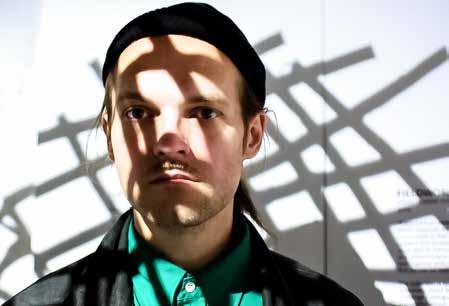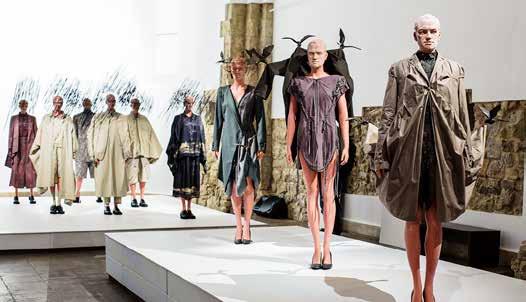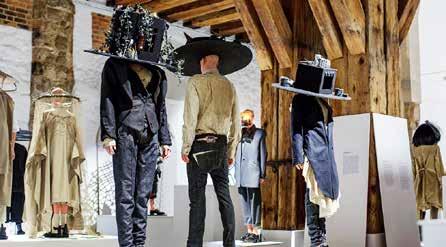
11 minute read
Interview MAREUNROL’S: “We want to create something that may become fashion in the future
by ALEXANDER WELSCHER MAREUNROL’S has a special place in Latvian fashion. Established by Mārīte Mastiņa-Pēterkopa and Rolands Pēterkops, it is the most recognised fashion brand from Latvia internationally and sometimes seems to be better known and understood abroad than at home. The recent exhibition “Altered States ofFashion” (10.10-08.12.2019) at the Museum ofDecorative Arts and Design in Riga was about to change that. Baltic Business Quarterly met with Rolands Pēterkops at the exhibition for a conversation about fashion and design, and to explore MAREUNROL’S creative process and his inspirations. “We want to create something that may become fashion in the future” Rolands Pēterkops, Co-Founder of MAREUNROL’S
The exhibition features around 30 clothing designs from 16 collections. How did you select the works to be included in it? The exhibition hall used to be a church. When we created the exhibition, it was all about working with the proportions and limitations of the space. We could not exhibit all collections here but just the most important ones from 2005 to 2019. It was difficult to select these pieces, because each item has a unique story. If it was bright in one of our collections, we wanted to show it. We also wanted to highlight how the costumes are constructed and the professional skills involved. We therefore also showed the sketches – how it all starts.
Advertisement
What do these works represent? It was important for us to show works that resonated with what was happening in the global fashion industry at the time of its creation or later. We always try to create not only a design object or a product, but also a visual story – a space – that is pure art and comes along with almost every collection of ours. This is why the silhouette of our clothes is very important to us. Presenting fashion is not just a story about garments, it is a story that also includes sound, movement, lights, colour and everything. That is how we see fashion.
Some of the pieces seem rather surreal It is indeed really funny. Many people who have seen pictures of our works think they have been photoshopped. But these are real pieces – real garments, real sculptural things. We work mostly with the silhouette and this is why some even say that we are sculptural artists – we make sculptures out of garments. And I could agree with this. The frame, the environment and all the space – it is so important for us. We like playing with tools, symbols and have several layers in the collection. And these kinds of elements help other people to understand. They might not be visible at first sight, but after taking a closer look you can see more details and there is a deep message. Each story has many nuances.
The main function of your fashion is thus not purely functional – clothes to dress a person The essence of clothing is, of course, to be worn but it can also tell bigger things. All the garments you see are wearable. It is very important for us to create wearable fashion. But we do not want to step into existing forms and present the current fashion. It is not that we produce things because someone asks us. No way. We want to create something that may become fashion in the future. It is not about avant-garde, it is about art. And it symbolizes some kind of road where
we visualize where people could go. We do not want to push our story and say it is the right one. We like people to have their own vision.
What is your understanding of fashion? Fashion should realize where we are now but we also have to take things and elements that we see through our modern eyes and create the next step – of beauty or art. Maybe today it doesn’t look so beautiful but in the context of tomorrow you will understand this beauty. Our goal is to present our design, our way of thinking and connect parts of fashion together to create our vision of fashion. By doing so, we try to create our signature. This is how we work and how we can tell something about fashion through our language.
So fashion is still about beauty for you? Fashion that we like is not about beauty that exists now. It is about what could be beautiful in the next season. We do not play with elements that exist now in fashion. We know what is happening in fashion but we do not want to squeeze in our collection of trends or things that exist only for a short time. We are happy when people can wear the same jacket ten years later. When it never becomes unfashionable or old, when the same values are not just a language of that time but are also understandable now.
Exhibition MAREUNROL’S. Altered States of Fashion
You also do costumes for theatre. Is that different to the regular design work? With costumes, the difference is that they are specially made for a specific space and a specific story. But fashion is more about everything around this. The possibility that your garment can be combined with other garments or can be worn in different positions over a lifetime. Theatre work is pretty ascetic. It is collective art. You work together with the director, the set designer, the actors and cannot push too many things from your own side. You have to give up your ego and the desire to turn the world upside down. The main goal is to express the play and that all works together well.
Do you see yourself more of a designer or an artist? Of course we are designers. That is what we do. We love to create garments. At
Mare un who?
Established in 2006, MAREUNROL’S is the most recognised Latvian fashion brand internationally. Its name refers to the fashion duo behind it: Mārīte MastiņaPēterkopa and Rolands Pēterkops. Both have taken part together in numerous competitions and festivals, biennials and exhibitions abroad. MAREUNROL’S has been listed among the most significant contemporary designers in various respected international magazines and at prestigious award ceremonies. The duo earned the two main prizes at the 24th International Hyeres Fashion and Photography Festival in France in 2009, and since 2012 regularly takes part in the Paris Fashion Week. Besides fashion, MAREUNROL’S has participated in several art projects and designed costumes for many theatre and opera productions in Latvia and abroad.

the same time, we both like to create the stories that make our collections work as art pieces globally. We mostly work in the art scene but we take out the design from there. We create design garments and try to step forward by holding onto our skills inside the fashion industry. Our main ambition from the very beginning was to push fashion to be more of a cultural event, to show that it is something serious and not just a cheap, fast show business thing. For us, fashion is an intrinsic part of culture and intellectual art. We sell garments as art pieces but we create them for humans, not for museums.
Where do you get the inspiration for your designs from? Mostly from daily life. We often sit together in the park and just try to take in everything happening around us. We are inspired by all sorts of things, random events or just certain moments. Especially the seemingly simple, naive things in life often turn out to be the best ones. Usually, they are associated with irony, humour or paradoxes. We then try to relate them later in our collections but beforehand, we talk and argue about what the best ideas and why we need them. Sometimes it is not so easy – we always want to create the highest story level.
How long does it take from the first idea to the final result? Fashion is a fast art, of course, a fast thing. Mostly you get the idea, draw the sketch and go straight to the fabric to start creating the garment.
We go to Paris twice a year – so two collections per year is the minimum. In earlier times, we sometimes used to work for one year on only one project. Now, we try to keep the balance between our customers’ needs and the language in which we want to create next-level fashion.
How difficult is it to maintain this balance? Well, a lot of the pieces are too expensive. Nowadays, fashion is supposed to be cheaper and faster. We do not work at the usual pace that is typical in the fashion industry, where some big brands produce several collections per year. We know too well that we do not have the capacity to compete with the clothing magnates, but we can stand out by creating unique fashion that doesn’t already exist in other brands. We want our language to talk globally, so people in Paris or from Asia can understand the stories and their symbols. They often just understand the silhouettes but this is how they remember the designer. This is how it worked for us with the bird collection. People were always saying, “the birds, the birds”.
Who buys your garments? How would you describe your clientele? We are not big commercial sellers. We produce only when we receive orders. Some stores in Japan sell our clothes. Customers usually come to Paris and order the collection. Then we produce and send it. That’s it. This is a very selective clientele that wants to buy and receive high-quality garments and is ready to pay a suitable price for it. We do not want to mass-produce our garments since larger volumes always require marketing and business staff. And then you become a slave to your own business. We do not have huge background investors as we created our own small business ourselves.
This is rather uncommon in today’s fashion industry Basically, there are only two roads nowadays. One is to follow a completely rational and calculated business approach. Create clothes, build up your brand and drive it to the market. Marketing will do the rest – you just have to have a big wallet. The other more complex approach is to develop your own language, your own vision and identity. This is what we do. We do not want to be one of the mass-producing brands that must try to sell quickly and destroys the environment. Nowadays, a great deal of fabric simply goes to waste – there are many leftovers. The biggest ecological problem now is bad design because there are so many designers and so many fashion companies that are producing, producing, producing. There are many similarities between all these brands that are just created since people are ready to buy so much. We see this as a huge problem and talk about these contradictions in one of our latest collections.
So you would never accept an offer to work for H&M or Zara Why not? We are not categorically against something and immediately say

“no”, but rather consider what the actual message is. If these big corporations are up for some kind of cooperation where we can create something good with better value for the future or see that we can educate people and say something new and fresh in the fashion industry, then why not. We are not absolutist – we understand the reality.
What materials do you work with? Our materials are mostly original and almost 100 percent natural. We try to combine the eco-friendly materials with natural ones. There was a period a long time ago when we used leather and also some synthetic materials. Now we somehow stick mostly to wool, as well as to cotton. We have good connections to wool factories in Italy, and the cotton we use is also mostly Italian or Portuguese. We mainly produce in Latvia, while some things are done in Lithuania. But as I said, we do not produce a lot - it is mostly small quantities.
What is your opinion about the Baltic fashion industry? There is no real fashion industry in the Baltics. We would be happy if there were one to build up good business here. But it is not possible. However, the good thing is that – due to this limitation – designers or artists are trying to create a language that is understood globally. Their ambition is to get out from the local area. In that case, it is somehow a good competition. That is why various designers from the Baltics are often represented at big fashion contests.
Are there any fashion designers who you also admire? We have, of course, been following some designers whose language is somehow interesting for us, like Junya Watanabe, Henrik Vibskovs, Craig Green, Hussein Chalayan and Jun Takahashi. We want to know what is happening in this industry – at least with the designers who are trying to say something and promote a similar kind of fashion as ours. Not totally similar, but at least when their tastes and ambitions speak through different languages as typical fashion brands.










